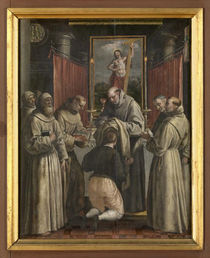The Catholic Defender: Saint Rose of Viterbo
- Donald Hartley

- Sep 4
- 3 min read
Updated: Sep 4
Deepertruth with special permission and aid with Franiciscan Media, a great team for the Lord
https://deepertruthdon.podbean.com/e/deepertruth-stand-in-the-gap-with-us-and-saint-rose-of-viterbo/

St. Rose was born in Viterbo (present day Italy) around 1233 C.E. Little is known about her life. She was born to a poor but devout family. Since a child, she held a deep love and passion for prayer and serving poor.
At the age of 10, the Blessed Virgin Mary was said to have told Rose to join the Third Order of St. Francis (a Franciscan lay order). So she donned the habit of the T.O.S.F. and as instructed by the Blessed Virgin, preached and emphasized penance and loyalty to the Catholic Church.
At the age of 10, she became a Secular Franciscan and soon began preaching in the streets about sin and the sufferings of Jesus. Viterbo, her native city, was then in revolt against the pope. When Rose took the pope's side against the emperor, she and her family were exiled from the city.
She is the patron saint of embroiderers, gardeners, florists, people who are harassed for their piety, and those suffering family problems. She is the patroness of the Americas, the indigenous people of the Americas, and of Peru, India, and the Philippines.
Rose was also known to be a visionary. On December 5, 1250, she foretold the death of the emperor which was fulfilled 8 days later on December 13. According to surviving evidence, Rose went to the city of Vitorchiano which was possessed by a sorceress. She not only converted the whole town, but the sorceress herself when she stood unharmed on a burning pyre for three hours.
Even as a child, Rose had a great desire to pray and to aid the poor. While still very young, she began a life of penance in her parents’ house. She was as generous to the poor as she was strict with herself. At the age of 10, she became a Secular Franciscan and soon began preaching in the streets about sin and the sufferings of Jesus.
Viterbo, her native city, was then in revolt against the pope. When Rose took the pope’s side against the emperor, she and her family were exiled from the city. When the pope’s side won in Viterbo, Rose was allowed to return. Her attempt at age 15 to found a religious community failed, and she returned to a life of prayer and penance in her father’s home, where she died in 1251. Rose was canonized in 1457.
The list of Franciscan saints seems to have quite a few men and women who accomplished nothing very extraordinary. Rose is one of them. She did not influence popes and kings, did not multiply bread for the hungry, and never established the religious order of her dreams. But she made a place in her life for God’s grace, and like Saint Francis before her, saw death as the gateway to new life.
And as she foretold, in 1257, Pope Alexander IV ordered for Rose's body to be exhumed and reburied within the monastery she so desired to enter. The Pope even had the monastery renamed after her.
200 years later, Pope Innocent IV canonized Rose as a saint. Her feast day is on September 4, the day in which her relics (her body) were transferred to the Monastery of St. Damian. The little saint still rests there today. Her body is in-corrupt meaning that it has not taken on the normal processes of bodily decomposition.
The list of Franciscan saints seems to have quite a few men and women who accomplished nothing very extraordinary. Rose is one of them. She did not influence popes and kings, did not multiply bread for the hungry, and never established the religious order of her dreams. But she made a place in her life for God’s grace, and like Saint Francis before her, saw death as the gateway to new life.
God our Father, for love of you Saint Rose gave up everything to devote herself to a life of penance. By the help of her prayers may we imitate her selfless way of life on earth and enjoy the fullness of your blessings in heaven.





















Comments